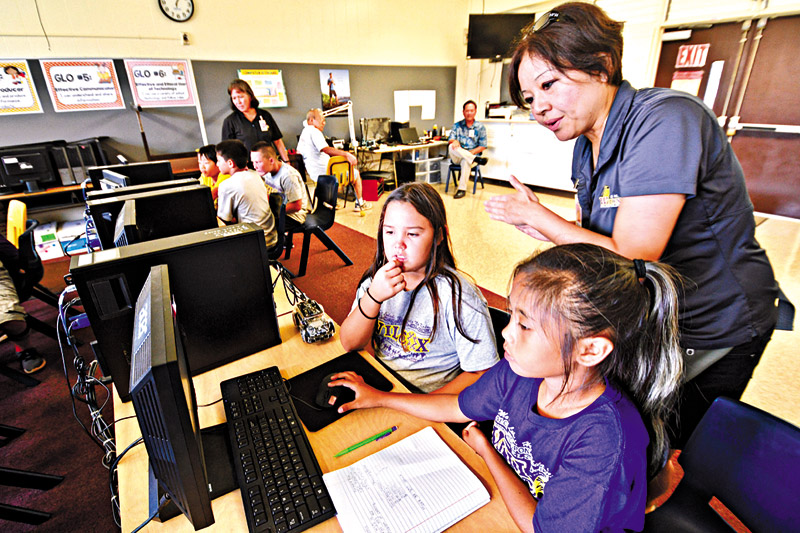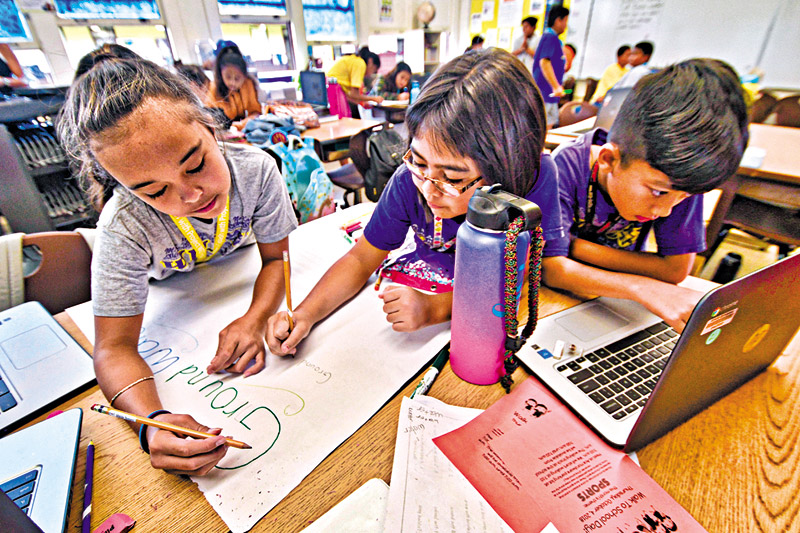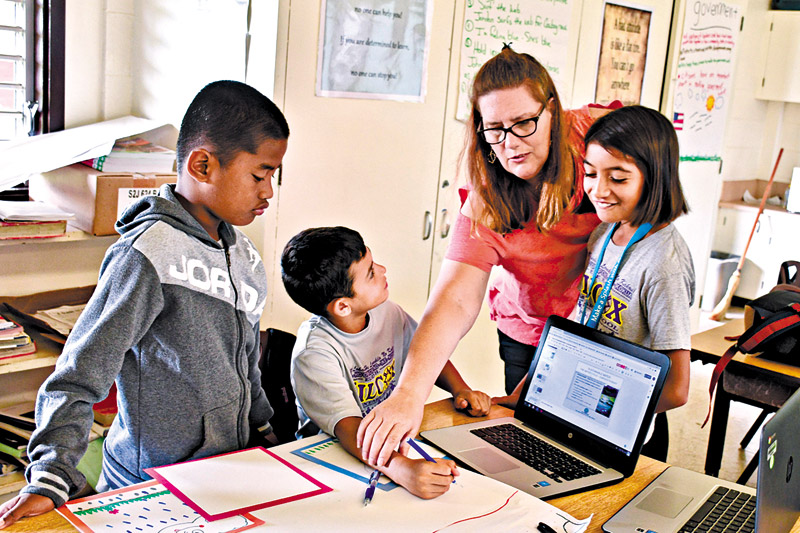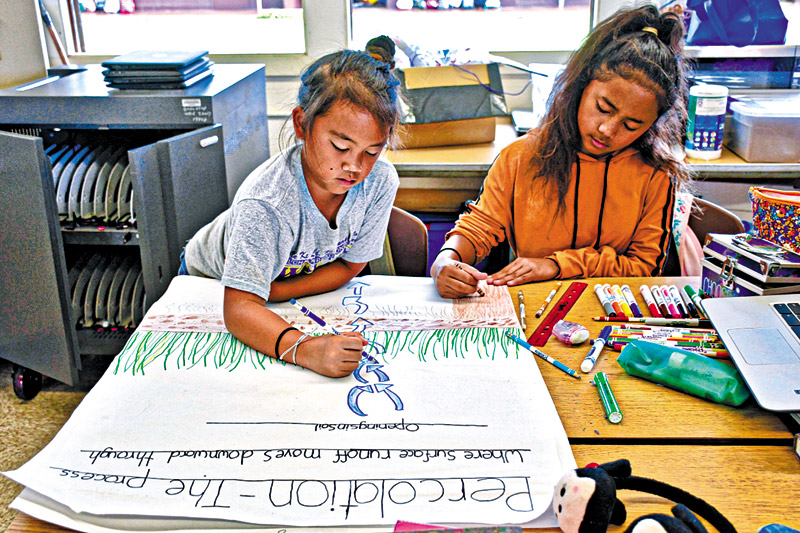Setting The Stage For STEM

Wilcox fifth-grade students Krista Kawamura and Kitana Bonilla code an electric vehicle with help from STEM teacher Natsumi Yamasato
Grove Farm’s new educational modules provide opportunities for Garden Isle students to explore STEM careers and industries.
This month, Wilcox Elementary School fifth-graders will trade in classrooms and textbooks for algae innovations, water treatment plants, caves, farms and solar power facilities as part of Grove Farm’s new educational modules.
The program that originated through a partnership between Grove Farm and Hawai‘i Institute of Innovation was a way to develop a unique educational platform.
“The overarching goal is to educate our youth about sustainable communities as it encompasses cultural, agricultural, scientific and state-of-the-art activities happening right here on the island of Kaua‘i,” states Grove Farm project manager Todd Ozaki. “Best of all, students and teachers have the opportunity to visit these sites and experience them firsthand.”
Once the educational modules were established and schools jumped in for the pilot, further collaboration with educators from public and private schools on Kaua‘i and O‘ahu, as well as Kaua‘i Community College, took place in June.
“Within the past month, we hosted over 100 Kaua‘i educators from Wilcox Elementary School and Chiefess Kamakahelei Middle School at the various sites in preparation for their students’ learning experience,” explains Ozaki.
Wilcox Elementary principal Corey Nakamura was part of that first group of pilot educators.
“There were a lot of places we saw that I never knew existed on Kaua‘i like the global algae farms, Tesla, Waiahi Surface Water Treatment Plant, and it was my first time to Makauwahi Cave,” he says.
Nakamura recognized that Grove Farm’s educational modules were an ideal fit with the Next Generation Science Standards being taught in Kaua‘i’s public schools. He also underscored the importance of community partnerships. “Luckily for us, we have Grove Farm providing the presenters and the sites for us to visit because funding is always a challenge,” he explains.
Although there is no cost to visit the sites on Grove Farm, each school is responsible for its own transportation costs.

Wilcox Elementary fifth-graders Madison Perreira, Maya Lambert and Christian Silva get started with their ground water vocabulary presentation.
“It’s not just science anymore,” Nakamura adds. “Next Generation Science Standards are place-based learning that will be taught from K to 12. It starts with a phenomena to get kids thinking — How does the sun generate electricity? — and that’s the kind of thing students can learn at the PV farm and the Tesla power plant.
“It incorporates more of the students thinking about things and not just gathering information to regurgitate that information, and maybe it even (has them) thinking about things that haven’t even been invented yet.”
For Wilcox Elementary School STEM teacher Natsumi Yamasato, learning the sustainability concepts and practices are a very important part of the Next Generation Science Standards.
“I believe that effective STEM teaching should include learning experiences that are relevant and meaningful to students’ lives,” she says. “I am very excited that students, as well as teachers, will have an opportunity to learn this component through hands-on and place-based learning together.”
It’s a sentiment echoed by Wilcox Elementary School fifth-grade teacher Barbara Bloemke.

Wilcox teacher Barbara Bloemke helps Jacob Bukoski, as teammates Stromel Latior and Anelalani Lee look on.
“This field trip is an amazing opportunity for our students to apply the critical thinking and hands-on techniques of Next Generation Science,” Bloemke adds. “The practices they use in studying these new standards more closely mirrors what scientists and engineers use in their professions, and I am hoping that students will consider some of the possible career opportunities that exist right here, giving them the opportunity to live their adult life in the place they grew up in.”
Through the program, students are exposed to STEM-related jobs and careers. They get a chance to observe scientists, archaeologists, biologists, engineers and information technicians at work, and get to interact with them and learn from them.
“The big purpose is the exposure to our students as we motivate our local students to go away and get an education, but come back and help our island in these areas,” Nakamura says. “There’s so many STEM careers available and much more yet that haven’t even been developed.
“I think with technology nowadays, it doesn’t limit anyone because we’re living on a small island. It doesn’t limit any one person to what the opportunities are and I think that’s a real big thing. Part of (our goal) is that we spark students interest, get them motivated, and build some hope so when they learn about science in school they can find something to relate it to, and they know anything’s possible. That’s what we want them to take away, that there’s no limit.”
As part of the program, each school then has an opportunity to design a Sustainable Community Solutions project and apply for a grant through Grove Farm Foundation to fund and implement its idea.
According to Nakamura, Wilcox Elementary School already has plans for their sustainability project.
“We can plant Native Hawaiian plants in the school’s greenhouse and donate these seedlings to people/organizations who are doing restoration,” he explains.
These educational experiences are not only for Kaua‘i’s youth, though. They’re also an opportunity for neighbor island keiki to participate, which enhances sharing, learning and networking. Grove Farm’s pilot schools were two Windward O‘ahu schools — including a Hawaiian immersion class that conducted and translated the modules into the Hawaiian language. Several O‘ahu schools will also be bringing their classes to the farm during the 2018-19 school year.
For more information on Grove Farm’s education modules program, visit grovefarm.com.





